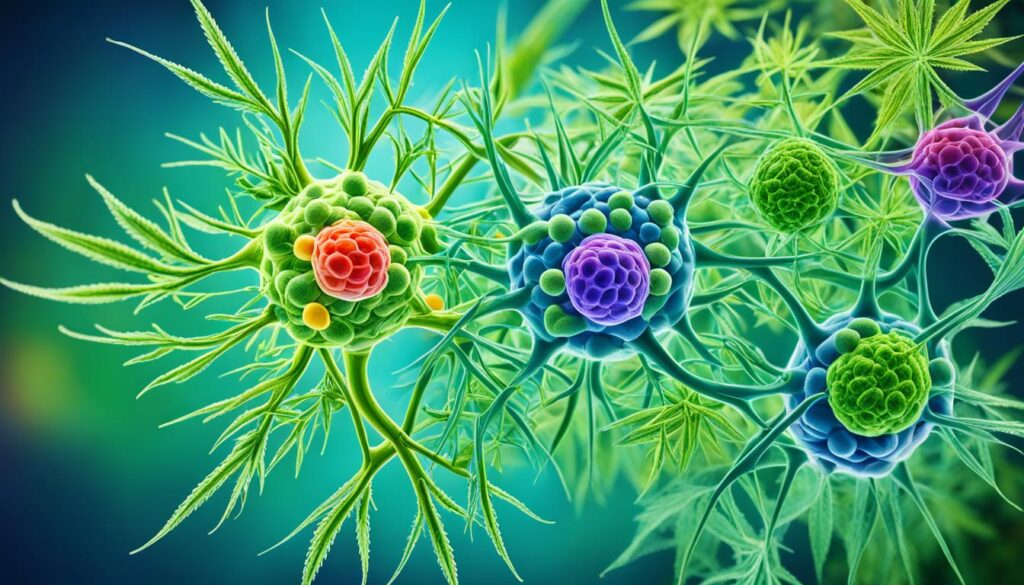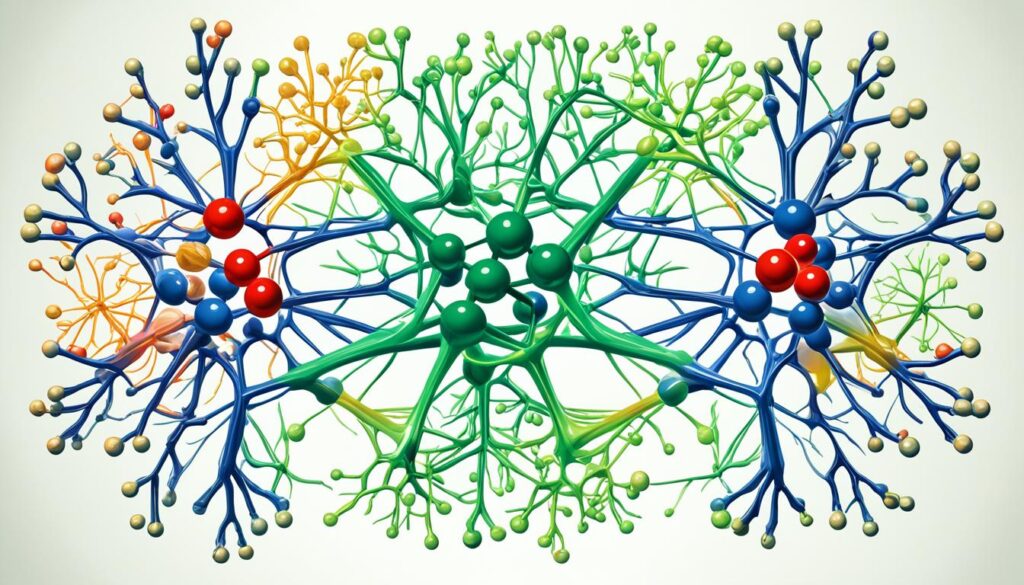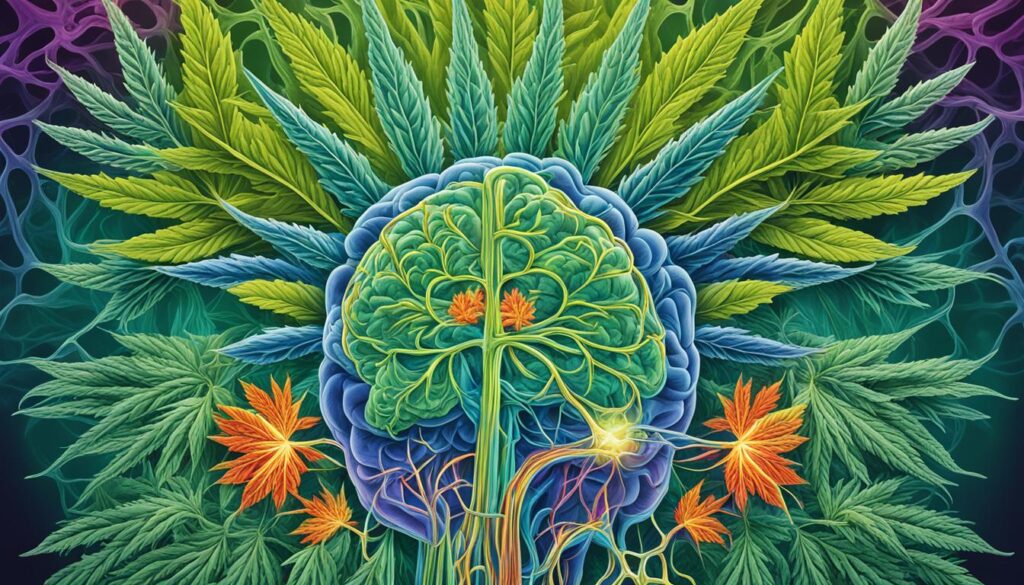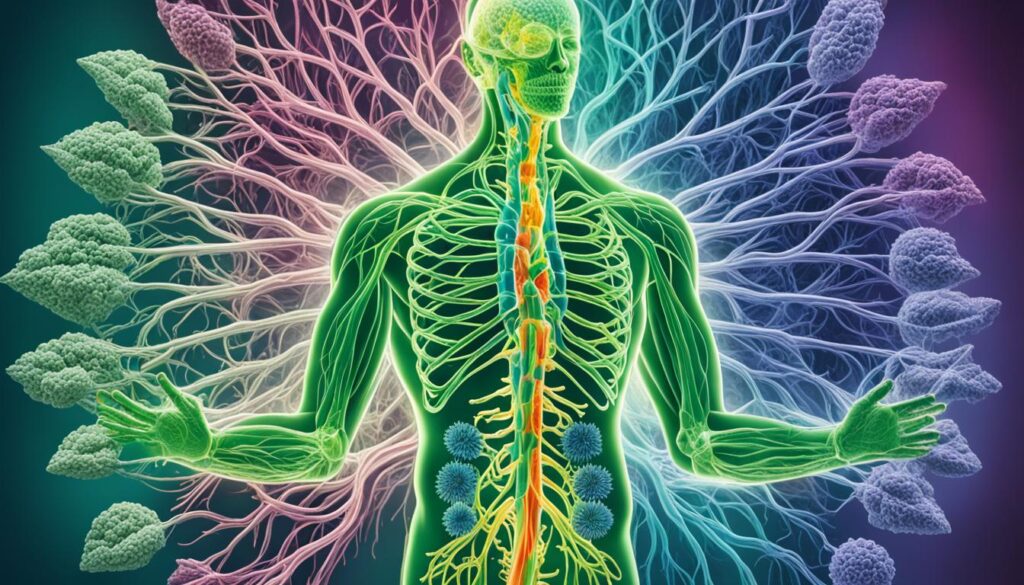Did you know our bodies have a special system to keep us balanced and feeling good? It’s called the endocannabinoid system (ECS). It’s super important for things like sleep, mood, hunger, and remembering.

People found the ECS in the 1990s. It has endocannabinoids, receptors, and enzymes that work together. Their job is to keep our inside world stable, a process known as homeostasis. But, how it all works is still a bit of a mystery.
Here’s something cool about the ECS. It interacts with cannabinoids like CBD, which comes from cannabis but doesn’t make you feel high. CBD helps endocannabinoids last longer in the body, making them more effective.
Key Takeaways:
- The endocannabinoid system (ECS) is a complex cell-signaling system that helps regulate various body functions.
- CBD interacts with the ECS and is believed to prevent the breakdown of endocannabinoids, enhancing their effects.
- The discovery of the ECS has opened up new research avenues for the potential therapeutic properties of CBD.
- The ECS plays a crucial role in maintaining homeostasis, which refers to the stability of the internal environment.
- Ongoing research aims to further understand the ECS and how CBD can be utilized for improved health and well-being.
The Endocannabinoid System and Its Functions
The endocannabinoid system (ECS) is key to our body’s balance and health. It helps control many things like hunger, how we feel pain, and our mood. This system also affects our sleep and how we learn and remember things.
CBD, a substance found in cannabis, works with the ECS to help our body in many ways. It can reduce pain, decrease feeling sick, and help with other health issues. CBD does this by working with the ECS, helping it work better.
Using CBD can help bring back balance to our body. This balance is important for being healthy. CBD’s effect on the ECS is one reason it’s considered for treating various health problems.
“The ECS is involved in regulating various processes in the body, including appetite and digestion, metabolism, chronic pain, inflammation, mood, learning and memory, sleep, cardiovascular function, and more.”
Taking CBD supports the ECS in keeping us healthy and balanced. Understanding and using CBD can offer a natural way to care for our health. It lets us look after ourselves in a way that works with our body’s natural systems.
The Components of the Endocannabinoid System
The endocannabinoid system (ECS) has three main parts: endocannabinoids, receptors, and enzymes. They help maintain the body’s internal balance and well-being.
Endocannabinoids: These are molecules made by the body, similar to the cannabinoids in cannabis. Anandamide and 2-arachidonoylglycerol (2-AG) are the most known. They regulate internal functions and keep the body balanced.
Receptors: The ECS uses cannabinoid receptors, mainly CB1 and CB2. CB1 is found in the brain, and CB2 in the immune system. They receive signals from endocannabinoids to create various responses.
Enzymes: These break down endocannabinoids after they’ve done their job. The key enzymes are FAAH and MAGL. They control how long endocannabinoids work.
CBD affects the ECS by slowing the breakdown of endocannabinoids, making their effects last longer. It may also attach to other, unknown receptors, which could explain its many potential benefits.
CBD could help with pain, inflammation, anxiety, depression, and sleep issues. Research is ongoing to fully understand how CBD works and its therapeutic uses.

| Components | Description |
|---|---|
| Endocannabinoids | Molecules produced by the body that regulate internal processes and maintain homeostasis. |
| Receptors | Cannabinoid receptors (CB1 and CB2) that endocannabinoids bind to, triggering physiological responses. |
| Enzymes | FAAH and MAGL enzymes that break down endocannabinoids once they have completed their function. |
| CBD | Interacts with the ECS by inhibiting endocannabinoid breakdown and binding to other receptors, potentially influencing a range of bodily functions. |
THC and CBD Interactions with the ECS
THC and CBD affect the endocannabinoid system (ECS) in different ways. THC can bind to specific parts of the ECS. This can lead to pain relief and more hunger.
CBD doesn’t bind the same way THC does. It might stop endocannabinoids from breaking down. This can make their effects stronger on the body.
CBD might also connect to other parts of the ECS we don’t know about yet. This could change how the ECS works and affect the body in various ways. Scientists are still figuring out how CBD does this.
THC and CBD can work better together. This is called the entourage effect. It means they might do more for your health when used at the same time.
“THC and CBD interact with the ECS in interesting ways. THC bonds with certain receptors, but CBD’s relationship with the ECS is subtler. Knowing how they work helps us see cannabis’s potential for health.” – Dr. Jane Green
Studying THC, CBD, and the ECS shows us possible health benefits of cannabis. Experts are learning how to use cannabinoids for better health treatments.
Here’s a simple comparison of THC and CBD’s effects on the ECS:
| THC | CBD |
|---|---|
| Binds to CB1 and CB2 receptors | Does not directly bind to CB1 and CB2 receptors |
| Produces psychoactive effects | Non-psychoactive |
| Stimulates appetite | Potential appetite modulation |
| Pain relief | Pain relief |
| May induce anxiety or paranoia in high doses | May have anxiolytic effects |

The table shows how THC and CBD have different effects due to their ECS interactions. These differences are key to understanding each cannabinoid’s unique potential for health benefits.
The Role of the Endocannabinoid System in Cannabis Interactions
The ECS connects cannabinoids like THC and CBD with our body’s processes. It helps control mood, pain, hunger, and sleep. By affecting the ECS, cannabinoids might help with these areas.
Clinical Endocannabinoid Deficiency
Some experts believe in clinical endocannabinoid deficiency (CECD). They think low endocannabinoids or ECS problems might lead to certain illnesses. Conditions like migraines, fibromyalgia, and irritable bowel syndrome might be affected.
The theory is based on the ECS’s crucial role in balance or homeostasis. If the ECS is off, it can upset various bodily processes.
Knowing how CBD and the ECS interact is key. CBD comes from cannabis and may help the ECS work better. This could bring everything back into balance.
Using CBD might be a way to help people with CECD. It may ease symptoms of migraines, fibromyalgia, and irritable bowel syndrome by supporting the ECS.
Yet, we need more research to fully get the link between ECS issues, CECD, and how CBD can help. Though some stories support CBD’s benefits, we’ve got much to learn about its effects.
Challenges in Research
Research on CECD and CBD’s impact has hurdles. The ECS is complex and impacts many body processes. This makes it hard to see its exact effect on certain illnesses.
Also, laws on cannabis make it tough to study CBD widely. Different places have different rules, affecting research funding and study quality.
Future Directions
Even with these roadblocks, we’re hopeful about CBD and the ECS theory. There’s growing evidence that CBD could help modulate the ECS.
More study could lead to better treatments. This includes using cannabinoids like CBD to improve ECS function. It’s a promising direction for health care.
Diving deeper into the ECS could lead to more personalized health solutions. We’re learning more about its role and potential issues.
Keep reading to discover the history of cannabis research. It’s fascinating how it has advanced our knowledge of CBD and the ECS.

The Discovery and Evolution of Cannabis Research
The Historical Journey of Cannabis Research
| Year | Significant Milestone |
|---|---|
| 1894 | Discovery of Cannabidiol (CBD) |
| 1964 | Isolation of Tetrahydrocannabinol (THC) |
| 1990s | Identification of Endocannabinoids and Discovery of the Endocannabinoid System (ECS) |
Cannabis research has a deep history. The discovery of CBD in 1894 sparked interest in the potential of cannabis.
In 1964, scientists isolated THC, the psychoactive part of cannabis. This encouraged more study on how cannabinoids affect us.
But it was the 1990s when the ECS was discovered. This changed how we see the body’s interaction with cannabinoids. It opened doors to new treatments.
Today, research keeps revealing how CBD and cannabinoids can benefit health. It’s a growing area of study for better health solutions.
The Discovery and Evolution of Cannabis Research
Cannabis research has come a long way, offering insights into this plant’s benefits. We will look at the history of CBD research. This history highlights the plant’s therapeutic potentials.
The Discovery of CBD and THC
In 1894, Irish physician Sir William Brooke O’Shaughnessy isolated CBD from cannabis. This was a huge step forward. It sparked interest in the plant’s medicinal qualities.
Decades later, in 1964, Dr. Raphael Mechoulam and his team isolated THC. THC is the compound that makes cannabis intoxicating. This finding helped us understand how cannabis affects us.
The Endocannabinoid System and Its Role
“The discovery of the endocannabinoid system (ECS) in the 1990s marked a significant breakthrough in cannabis research.”
In the 1990s, Drs. Lumír Hanuš and William Devane discovered the ECS. The ECS is key in regulating our physiological processes.
The ECS maintains balance in our bodies. It influences mood, sleep, appetite, pain, and immune response. Understanding the ECS explained how CBD affects us.
Ongoing Research and the Potential of CBD
“Ongoing research continues to unlock the remarkable therapeutic potential of CBD and other cannabinoids.”
Research on CBD’s therapeutic potential has grown. Studies have looked at its benefits for pain, anxiety, epilepsy, and inflammation.
Scientists have learned a lot about CBD’s role in the ECS. CBD’s interaction with the ECS affects our health in many ways. This opens the door to many uses for CBD.
The Role of Cannabinoid Receptors in the Body
The endocannabinoid system (ECS) is complex and fascinating. Within it, cannabinoid receptors are key in controlling various bodily functions. There are two main types: CB1 receptors and CB2 receptors.
CB1 receptors are mostly in the central nervous system, including the brain and spinal cord. They help manage pain, mood, memory, and appetite.
CB2 receptors are mostly outside the brain, in tissues and immune cells. They are important for controlling immune reactions, swelling, and pain outside the brain.
Endocannabinoids from our body activate these receptors. This starts certain signals that affect our health. What happens next depends on the endocannabinoid and where the receptor is.
For example, an endocannabinoid might change mood or lessen pain by acting on a CB1 receptor in the brain. Or, it could control inflammation by acting on a CB2 receptor in immune cells.
CBD, a compound in cannabis, also interacts with these receptors but in a special way. It doesn’t directly bind to either CB1 or CB2 receptors. However, it influences the ECS in other ways that scientists are still studying.
The way CBD interacts with cannabinoid receptors is only one part of its complex relationship with the ECS. Scientists are still trying to understand exactly how CBD affects the ECS and its benefits.
“Cannabinoid receptors, including CB1 and CB2 receptors, are vital components of the endocannabinoid system and play a crucial role in regulating various bodily functions.”
We need more research to fully understand how CBD, cannabinoid receptors, and the ECS work together. Yet, it’s becoming clear that focusing on these receptors can greatly impact health and well-being.

The Interaction of CBD with Anandamide and 2-AG
Understanding how CBD works with the body requires a look at anandamide and 2-AG. These endocannabinoids are key for many bodily functions. CBD is thought to interact with these to affect our health.
Anandamide is called the “bliss molecule.” It helps with mood, pain, stress, and sleep. It connects to CB1 and CB2 receptors in the body. CBD might stop anandamide from breaking down. This makes it more effective at managing these functions.
2-AG also has a big role in pain management and immune health. It acts as a “circuit breaker” for too much inflammation. CBD might help stop 2-AG from breaking down too. This could boost its role in pain relief and immune support.
CBD might also work with TRPV1 receptors. These receptors help control temperature and pain feelings. By affecting TRPV1, CBD could help with pain relief.

“CBD’s interaction with anandamide and 2-AG showcases its potential to modulate the endocannabinoid system and promote overall balance and well-being.” – Dr. Jane Thompson, Neuroscientist
| Endocannabinoid | Role |
|---|---|
| Anandamide | Regulates mood, pain, stress, and sleep |
| 2-AG | Plays a role in pain modulation and immune system regulation |
Learning how CBD interacts with anandamide, 2-AG, and TRPV1 receptors is insightful. It shows CBD’s possible health benefits. As research goes on, the complex ways CBD works with the endocannabinoid system become clearer. This opens new doors for using CBD to improve our well-being.
The Pleiotropic Effects of CBD
CBD has various effects due to its interaction with many molecular pathways. These actions can greatly benefit the body. They offer a range of potential health benefits.
CBD is known for its anti-inflammatory benefits. Studies show it can lessen inflammation. This is good news for those with arthritis or inflammatory diseases. It targets inflammation, easing pain and discomfort.
CBD also helps manage pain. It works with the body’s pain sensors to lower discomfort. This makes CBD a good option for chronic pain, without the downsides of typical painkillers.
Besides, CBD can reduce anxiety and stress. It works with brain receptors that control how we feel stress and anxiety. This could help people with anxiety disorders or PTSD find calmness.
CBD might also protect the brain. It could guard brain cells against damage or decline. This opens possibilities for treating diseases like Alzheimer’s and Parkinson’s.
It’s crucial to remember that CBD’s effects are still under study. Research is ongoing to understand how CBD benefits the body. Scientists are learning more about how CBD works with the body.
The Potential Therapeutic Properties of CBD:
- Anti-inflammatory effects
- Analgesic effects
- Anxiolytic effects
- Neuroprotective effects
Our knowledge of CBD and its health benefits is growing. CBD could improve health in many ways. From pain relief to reducing anxiety and protecting the brain, CBD’s effects are wide-ranging.

The Future of CBD and ECS Research
The discovery of the endocannabinoid system (ECS) has changed medical research. Scientists are exploring how CBD and ECS can help with many conditions. This includes Alzheimer’s, Parkinson’s, anxiety, depression, chronic pain, and immune disorders.
Our knowledge of the ECS and CBD is growing fast. Researchers are learning how CBD works with the ECS. This could lead to new treatments that change how we manage health problems.
More people are seeing the potential of CBD. This means more research on how it affects different health issues. Scientists are looking into the future, excited about what they might find.